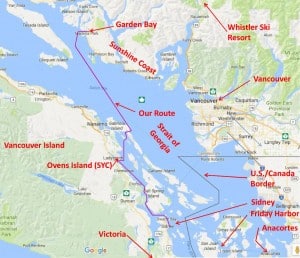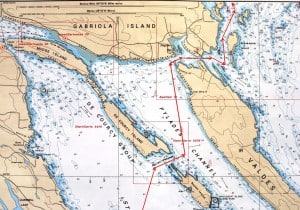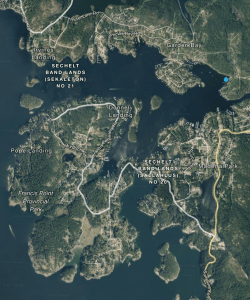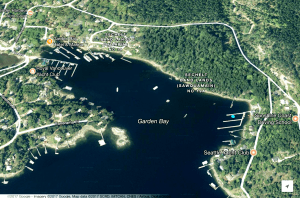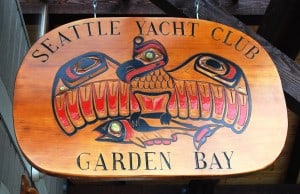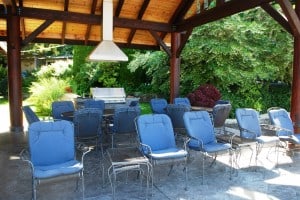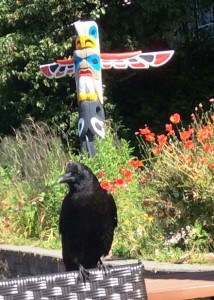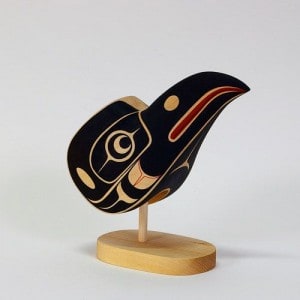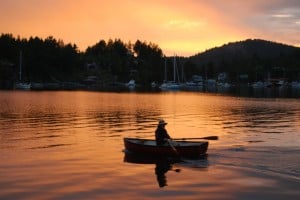It’s A Favorite Place. We have several favorites in the crown jewel outstations owned by the Seattle Yacht Club, but Garden Bay – deep into Pender Harbour – is definitely the cream of the crop for us. We typically visit it twice a year, on the way north in the early summer, and again on the way south at the end of summer – and at those times it’s usually not crowded with other member boats (after July 4th, and for the next month, the docks are packed with boats – and then it’s not such a great place for us.
If you want to see where we are now, or better yet, monitor our route progress as we cruise along, you can go to www.ronf-flyingcolours.com and click on the Current Location link in the upper right corner of the home page. Also, this post is more readable in the online version, plus you can read any of the posts back to 2010 from the archive – just click on the link above to the blog. And don’t forget – you can click on any photo in the post to enlarge it.
But first I need to chronicle how we got here. The map at left shows our route over the past two weeks from Anacortes to Garden Bay. The longest leg so far was Day 9, a 49 mile cruise from Ovens Island (at the entrance to Ladysmith Harbour), through the narrow passage that separates Gabriola and Valdes Islands, and opens onto the large Strait of Georgia (also known as the Salish Sea).
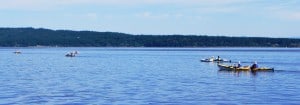
We often see kayakers crossing our path, and it's something we really need to keep an eye out for. They're sometimes hard to see, and our wake can easily swamp them.
Early in the day, our first narrow passage was completely benign, through Ruxton Passage that separates De Courcy and Ruxton Islands, but just as we reached the eastern edge of the passage Kap spotted five kayakers crossing our bow. This isn’t a problem – provided you see them in time – and you certainly want to slow to idle speed while passing them, as the wake from our boat could easily swamp a kayak.
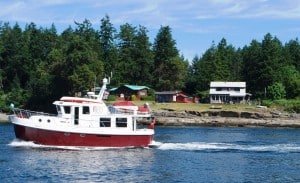
At the west entrance to Gabriola Passage we met an American Tug completing it's transit to the west. This southernmost tip of Gabriola Islans has a cluster of very nice retirement or second homes.
At the west entrance to Gabriola Passage, the water looked pretty calm, and we met an American Tug (similar to Cosmo Place, our earlier Nordic Tug) that had apparently just transited the Passage. This is at the southern tip of Gabriola Island, and as you can see in the photo, there’s a small cluster of picturesque summer homes on the point – making it a great place to watch boats passing by.
Our transit at the narrowest point of Gabriola Passage, though, wasn’t as benign as we’d have liked. With a long cruising day ahead, particularly with a report of higher-than-we’d-like winds coming up in the afternoon during our 30+ mile crossing of the Strait of Georgia, we were hoping to push the slack time a bit at the passage. At maximum tide ebb (i.e., with the tide on our nose), the water current speed at the narrowest point of the passage was forecast to be 8 kts, and if you’re only going 8 kts through the water, your actual forward speed over the ground would be zero. We hoped to go a bit earlier than slack, when the water current speed was maybe 2 kts – which it appeared to be on our arrival.
Kap was at the helm while I called out depth readings and water current speed against us from our instrument cluster. All looked good until we reached the real pinch point of the passage, which is shown as Cordero Point on the chart. Suddenly Kap noticed a large swirling whirlpool that completely filled the passage ahead of us. She rammed the engine throttles to the firewall just as we caught the sideways waters of the whirlpool. In an instant, Flying Colours was whipped almost 90° to starboard and Kap gave the wheel almost three complete turns to the left to counteract it – hopefully before we were slewed into the shallow part of the passage. If we hit the underwater rocks we’d be finished! Our powerful rudders overcame the force of the water, and as we heard banging and clanging of “stuff” being thrown around back in the salon, Flying Colours came around to port, and Kap had to whirl the wheel back to the right. By now, Kap’s initial reaction – “more speed, Scotty!” – pushed us through the other side of the whirlpool . . . and through the passage itself. We stared at each other in disbelief, as that little episode was totally unexpected, and we were both shaken. (Surprisingly, ZuZu never let out a whimper, and Jamie was still asleep on her pad in the fly bridge.) When transiting safely, passages are supposed to be boring, but this one proved to be anything but boring, and it sure reminded us not to be complacent.
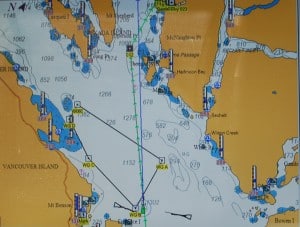
Flying Colours approaching Whiskey Gulf - the Navy torpedo range that always has to be taken into account.
Once out in the open Strait of Georgia, our next notable area was Whiskey Gulf (abbreviated WG) – the outlined trapezoidal-shaped “box” in our chart plotter image at left. You can “see’ Flying Colours as the green boat-shaped symbol at the bottom middle of the image, and it shows us just about to enter WG. The lines emanating upward from Flying Colours are our expected course based on the direction we’re currently steering. The two black and white boat images on either side of us are AIS vessel tracking indicators, and they show two gigantic B.C. ferries that are heading directly for us at the time I snapped this photo (and they travel at over twice our speed). But a collision isn’t imminent, as I had zoomed the chart plotter image way out so that it would show almost all of our intended course lines. Each ferry is close to a mile away from us, and will easily pass by us on the stern as we continue on our course.
WG is the submarine and surface ship torpedo practice range that’s operated jointly by the Canadian and U.S. Navies. Earlier radio reports that we’d listened to all morning from the Canadian Coast Guard indicated that WG was “not active”, allowing us to cross it. When WG is “hot”, Navy ships patrol the perimeter like a hawk and a Coast Guard observation center on the shoreline to the west of it sweeps the area with radar. If you’re caught inside when it’s hot, you’ll catch hell on the radio, and a Navy ship will escort you right out of it. Beneath the surface, 300-400 torpedoes are tested annually, mostly American, and mostly from surface ships. Suffice it to say, it isn’t a place to be trifled with, yet we’re always surprised how many radio calls we’ve listened to between the Canadian Navy to boaters who have entered it when it is hot.
Garden Bay Outstation. We arrived at Garden Bay at 3PM, which made it a 6-hour cruise, and for the 49 mile crossing it averaged just a hair over 8 knots (just over 9 MPH). (A lot of non-boaters – and boaters who have fast boats – often ask how you can stand to dawdle along at 9 MPH, but in fact, it’s plenty fast for the kind of cruising we prefer to do. As I said in an earlier post, we’re not doing this to be there, but rather, the getting there.)
To our surprise, there was only one other boat at the outstation docks, and we had the pick of the very best places to moor – the end of the main dock, bow in, with the stern (cockpit) pointing out to the sunset.
Shortly after our arrival at Garden Bay I snapped two screen capture images of Garden Bay, the first showing the overall outline of Pender Harbour (with Garden Bay at the deepest point within the harbor), and the second a close-up of Garden Bay itself. In both, we are the little blue dot moored at the SYC outstation dock. As you can see, Pender Harbour is very elaborate and convoluted, with miles and miles of shoreline dancing around dozens of land protrusions. This is the northernmost area of what’s known as The Sunshine Coast of the British Columbia mainland coastline, and areas like this are dotted with retirement and vacation homes for Vancouverites, or people just wanting to get farther away from the big city. As you can see from the up-close image, directly across from the SYC outstation is one for the Royal Vancouver Yacht Club.
A Native American-style carving similar to the one at left adorns every one of the 11 SYC outstations, carved by an SYC member years ago and donated to the club.
The club bought this outstation at least 20 years ago, and all the time we’ve been coming here there has been the same European immigrant couple (Vera and Vladimir) as outstation caretakers. The property had a fairly nice home on it when the SYC purchased it, and the caretakers are paid a salary, plus live in the on-site home free of charge. In exchange, they take care of the property, and oversee member use of the facilities to ensure that club rules are followed. Vera and Vlad retired at the end of last boating season, and a new couple have taken over. It was good to meet them, and we get the feeling they’ll do a great job of making sure this outstation remains a jewel.
By the end of the afternoon, four additional boats had arrived, and with that, one of them declared a “green box” at 5:30PM. This is an SYC tradition that dates back decades, and refers to a potluck appetizer-only get-together – everyone bring their favorite appie and drink in hand, to shoot the breeze and have a good time before the dinner hour back on the boat. These aren’t every night affairs, and in fact, in the ten years we’ve been in the Seattle Yacht Club, a Green Box has only been called maybe a dozen times while we’ve been at a club (in July as some outstations, it’s likely, though, that there’s a green box almost every night). Nevertheless, I always provision the boat with my best appie fixin’s just in case one is called. This time, though, it was on such short notice that all I could do was take a plate of tortilla chips and some really good Mexican salsa that we always pick up in Sidney. I had lots of other stuff – chorizo sausages in red wine sauce, or little pig sausages wrapped in crescent rolls, or stuffed mushrooms – but it was either all frozen or would take me more than an hour to prepare. Tonight’s Green Box was small – no more than five total couples, and we didn’t know any of them beforehand, so it was great to have it.

At the dinghy dock, Madeira Park. Kap is in our dinghy, second from right; Jamie is waiting on the dock.
The next day Kap and I dinghied into the tiny village of Madeira Park, which contains about ten businesses and a proper boat marina, including a good IGA where we always provision before heading to the more remote north at Desolation Sound. We were having a very good outdoor lunch at a café across from the IGA when Kap whispered that I should grab my iPad and turn around for a photo. It was a raven sitting on a chair back at the next table, with a colorful totem pole just above his head and behind him in the field. The raven is one of the important symbols in First Nation’s art, and while this totem is capped at the top with a bird, the curved-down beak indicates it’s an eagle, not a raven.
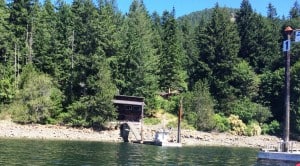
Edith Iglauer's house is almost hidden in the trees. The dock and beach cagin are part of her property. SYC Dock #1 is just barely visible at lower right.
Our famous outstation neighbor. At the Garden Bay outstation, we have an interesting neighbor – an American expat who turned 100 years old just two months ago – named Edith Iglauer (not a name that rolls off the tongue). According to the Wikipedia page about her (https://en.wikipedia.org/wiki/Edith_Iglauer), she was born in Cleveland (OH), attended Wellesley College and Columbia University, and with a strong interest in Eskimo cultures she spent much of her life on the coast of North America. At some point she married a Canadian fisherman, John Daly, and for 40 years they lived aboard his 40′ fishing boat. At some point the fishing boat was sold, he retired as a fisherman, and they purchased the property beside the property that became the SYC outstation.
For most of her life she was an author, and her most well-known book is Fishing With John (not to be confused with a movie titled Fishing With Jim that I suspect is rather horrible) – and the fisherman in the book is patterned after her husband. The movie created from this book – Navigating The Heart – is what she’s most famous for, and the movie trailer describes the book as “an unlikely romance between a cosmopolitan woman and a small town fisherman”. Navigating The Heart was made in2000, starring Jaclyn Smith of Charlie’s Angels fame and David Andrews. In addition, Edith Iglauer has been a regular contributing author for many years to The New Yorker magazine (which I’ve subscribed to for years, and I read several articles from the digital edition every day).
If you’d like to read one of her New Yorker magazine articles, I located one titled “Sitting On Water”, a brief and very well-written story about life at Garden Bay, and in particular, an experience in buying her first boat – a very tiny dinghy with a 9 HP outboard motor – which she called her “container on which to sit on the water”. You can find an archived copy at https://web.archive.org/web/20080703160643/http://www.geist.com/dispatches/sitting-water.
Our small association with this noted author came about in 2011, when Kap and I were watching from our boat’s cockpit as an amazing sunset just seemed to get better and better. Suddenly, a lady at Edith Iglauer’s next door dock climbed into her small rowboat and passed behind us, very obviously on a mission. I instantly knew it would be a great photo as she passed by our stern, and as you can see, it’s pretty close to being a photo competition candidate (and this photo is not Photoshop’d). The evening was quiet enough that she could hear the fake shutter sound on my Nikon digital camera, and when she looked over I apologized for taking her photo without asking, telling her I only had a moment to shoot and decided to take it first and ask permission later. She rowed over to talk with us and we had a very interesting chat. She lives just a short distance away on the water’s edge, and she told us that she rows over every night, bringing dinner and an evening’s discussion with Edith Iglauer. She asked for a copy of the photo to send to her son in England, and for the rest of our stay we’d wave to each other as she passed. We haven’t seen her now for several years, but I often think about this photo.
By the time I’ve finally posted this, Flying Colours has headed north and is at the Cortes Bay SYC outstation. We’re headed further north after two nights here, and will next be at Blind Channel Resort – the entrance to The Broughton’s, and then on to Port McNeill near the far northern tip of Vancouver Island.

